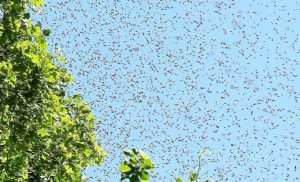Honeybee Swarms
So, what is a swarm anyway?
For some, it’s what nightmares are made of, but it’s actually a harmless and quite fascinating event to see. A swarm may contain from 1,500 to tens of thousands (usually only in extreme cases) of  bees including, workers, drones, and a queen. Swarming is part of the annual life cycle of a honeybee colony and is completely natural. Each year a honeybee colony fulfills its instinct to reproduce by casting these swarms out of existing colonies. Other reasons for swarming include overcrowding, and absconding, which is when an entire colony leaves an old nesting site due to unsavory conditions. Normally, in managed hives, the beekeeper takes steps to prevent swarming so their neighbors aren’t surprised by the sight of thousands of bees flying through their yard, but not all bees live in managed hives. The bees you see may be living out in the wild in hollow trees or other cavities they call home.
bees including, workers, drones, and a queen. Swarming is part of the annual life cycle of a honeybee colony and is completely natural. Each year a honeybee colony fulfills its instinct to reproduce by casting these swarms out of existing colonies. Other reasons for swarming include overcrowding, and absconding, which is when an entire colony leaves an old nesting site due to unsavory conditions. Normally, in managed hives, the beekeeper takes steps to prevent swarming so their neighbors aren’t surprised by the sight of thousands of bees flying through their yard, but not all bees live in managed hives. The bees you see may be living out in the wild in hollow trees or other cavities they call home.
When does this normally happen?
Normally late spring to early summer, when their population has jumped up greatly. In the Delmarva area this would most likely fall between March and June.
 Will they hurt me, my kids or my pets?
Will they hurt me, my kids or my pets?
No. Honeybee swarms are very gentle. Honeybees are defensive, not aggressive. Honeybees defend their nests to protect their young and their food. Swarms have neither of these things to defend. You will only receive stings from honeybee swarms if you provoke them by grabbing or smacking at them, which most people are not interested in trying. Naturally, I recommend keeping children and pets clear of a honeybee swarm. I know from experience that my dogs like to snap at flies and bees as they swirl around and kids can be unpredictable! Just leave the swarm alone until a beekeeper arrives to remove them safely.
Okay, what now?
Call a beekeeper! Beekeepers are working hard to make sure the dwindling honeybee population has a chance to recover. DO NOT spray poison or pour gasoline on the bees. You can contact us  at 443-944-4840 for your swarm removal needs. We will have a few questions about the swarm that will help us bring the right equipment for the job.
at 443-944-4840 for your swarm removal needs. We will have a few questions about the swarm that will help us bring the right equipment for the job.
- How large is the swarm? Most of the time a “sports ball” metaphor is used. It’s “softball sized” or “basketball sized”.
- Where is the swarm? What have the settled on? Tree branches and bushes are common, but at times they’ll choose hard surfaces like fence posts or bird baths. If they’re coming and going from a hole in a structure or tree, you don’t have a swarm. You most likely have an established colony which requires a lot more work and preparation.
- How high up are they? Are they way up in a tree or on the corner of a house? Please be honest here. We’ll want to be prepared for the heights.
What will you do when you get here?
Honeybee swarms are looking for a new home, so I will provide them with one. In most cases, the cluster of bees is shaken off of the tree branch or other object into a hive box filled with frames. I typically include frames that have been used by other bees, which the swarm will recognize and be attracted to. If possible, the queen bee will be captured and caged inside the box. The cluster will follow the queen into the box and, once most of the bees have moved inside, the box is closed up and taken to the apiary. Once there the bees will be given food and resources they need to get their new colony started successfully.

What does this cost?
Swarm removal costs vary depending on how far I have to travel and how hard the bees are to reach. It’s not usually much more than covering my gas, though. For more information on costs associated with bee removal, please see this page.
For honeybee swarm removal, give us a call at (443) 944-4840